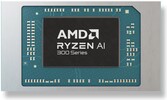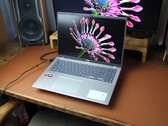
Un OLED da 1.100 nit e AMD Zen 5 in un computer portatile per creatori - La recensione di Lenovo IdeaPad Pro 5 14 G10
AMD Ryzen AI 7 350 | AMD Radeon 860M | 14.00" | 1.4 kg

Ryzen AI 7 PRO 360 è un processore relativamente potente della famiglia Strix Point che ha debuttato nell'ottobre 2024. L'APU con architettura ibrida ha 8 core CPU a bordo (un mix di tre core Zen 5 e cinque core Zen 5c) che funzionano a una frequenza da 2,0 a 5,0 GHz, insieme alle 12 CU RDNA 3,5 Radeon 880M e al motore neurale XDNA 2 da 50 TOPS. Il Secure Processor di AMD (che in poche parole è un co-processore ARM on-package) è presente a bordo, così come alcune altre caratteristiche di fascia alta come AMD-Vi. Altre caratteristiche chiave includono PCIe 4, USB 4 e supporto RAM fino a LPDDR5x-8000, inclusa RAM ECC.
Architettura e caratteristiche
Le APU della famiglia Strix Point sono alimentate dai core della microarchitettura Zen 5 e Zen 5c, che si trovano in due cluster separati; quest'ultimo è una versione leggermente più lenta, più piccola e più efficiente dal punto di vista energetico del primo. Una delle differenze tra Zen 5 e Zen 5c è la dimensione della cache; i core Zen 5 hanno cache più grandi con cui lavorare.
In ogni caso, l'implementazione di Zen 5 mobile è, secondo quanto riferito (ChipsAndCheese) più vicina allo Zen 4 per desktop che allo Zen 5 per desktop, a causa delle diverse dimensioni della cache, delle grandi differenze nel throughput AVX-512 e di altri fattori.
Altrove, il chip Ryzen AI 7 PRO supporta la RAM DDR5-5600 e LPDDR5x-8000, offrendo ai progettisti di sistemi la scelta tra una latenza più bassa e un throughput più elevato rispettivamente. Il chip è nativamente compatibile con USB 4 (e quindi con Thunderbolt). Ha il supporto PCIe 4.0 per un throughput di 1,9 GB/s per corsia, proprio come i suoi predecessori della serie 8000. La NPU XDNA 2 integrata, molto più complessa rispetto alla XDNA di prima generazione, offre fino a 50 INT8 TOPS per accelerare vari carichi di lavoro AI.
Come di consueto per le CPU dei computer portatili, il chip Ryzen 7 AI PRO non è sostituibile dall'utente, in quanto viene saldato per sempre.
Prestazioni
Ci aspettiamo che questo processore della serie PRO sia dal 15% al 25% più lento rispetto al 10-core Ryzen AI 9 365 per Core Ultra 7 155U-come i punteggi dei benchmark multi-thread. Naturalmente, molto dipende da quanto sono alti gli obiettivi di potenza, che possono differire enormemente tra i vari progetti.
Grafica
La Radeon 880M è il diretto successore della 780M. Presenta diverse differenze sotto il cofano, come cache più veloci; le sue 12 CUs/WGP dell'architettura RDNA 3.5 (768 shader unificati) funzionano fino a 2.900 MHz. Con oltre 30 fps sia in Once Human che in The First Descendant (1080p - Basso), questa iGPU AMD è sicuramente abbastanza veloce per un gioco casual e competitivo.
Naturalmente, la Radeon è in grado di pilotare quattro monitor SUHD 4320p60. Inoltre, è in grado di codificare e decodificare in modo efficiente i codec video più diffusi, come AVC, HEVC, VP9 e AV1. L'ultima aggiunta a questo elenco, il codec VVC, non è supportato a differenza dei chip Intel Lunar Lake.
Consumo di energia
Si suppone che la 360 abbia un obiettivo di consumo TDP a basso termine di 28 W, con i produttori di laptop liberi di aumentarlo fino a 54 W. Cosa che molto probabilmente faranno per massimizzare le prestazioni.
Il processo TSMC a 4 nm con cui sono costruite queste CPU garantisce un'efficienza energetica superiore alla media, a partire dalla fine del 2024.
| Nome in codice | Krackan Point (Zen 5) |
| Clock Rate | 2000 - 5000 MHz |
| Level 2 Cache | 8 MB |
| Level 3 Cache | 16 MB |
| Numero di Cores / Threads | 8 / 16 4 x 5.0 GHz AMD Zen 5 4 x 3.5 GHz AMD Zen 5c |
| Consumo energetico (TDP = Thermal Design Power) | 28 Watt |
| TDP Turbo PL2 | 54 Watt |
| Tecnologia del produttore | 4 nm |
| Socket | FP8 |
| Features | DDR5-5600/LPDDR5x-8000 RAM, PCIe 4, USB 4, XDNA 2 NPU (50 TOPS), Secure Processor, SMT, AES, AVX, AVX2, AVX512, FMA3, MMX (+), SHA, SSE, SSE2, SSE3, SSSE3, SSE4.1, SSE4.2, SSE4A |
| GPU | AMD Radeon 860M ( - 3000 MHz) |
| 64 Bit | Supporto 64 Bit |
| Architecture | x86 |
| Data di annuncio | 01/06/2025 |
| Collegamento Prodotto (esterno) | www.amd.com |


Asus Zenbook 14 OLED UM3406KA: AMD Radeon 860M, 14.00", 1.2 kg
Recensioni esterne » Asus Zenbook 14 OLED UM3406KA
» Confronto CPU Mobile
Confronto di tutte le serie di CPU mobile
» Processori Mobile - Elenco Benchmark
Elenco Benchmark di tutte le CPUs conosciute, usate nei portatili (CPUs desktop e portatili)
I nostri Top 10
» Top 10 Portatili Multimedia
» Top 10 Portatili Gaming
» Top 10 Portatili Gaming Leggeri
» Top 10 Portatili da Ufficio e Business economici
» Top 10 Portatili Premium da Ufficio/Business
» Top 10 Portatili sotto i 300 Euro
» Top 10 Portatili sotto i 500 Euro
» Top 10 dei Portatili Workstation
» Top 10 Subnotebooks
» Top 10 Ultrabooks
» Top 10 Convertibili
» Top 10 Tablets
» Top 10 Tablets Windows
» Top 10 Smartphones